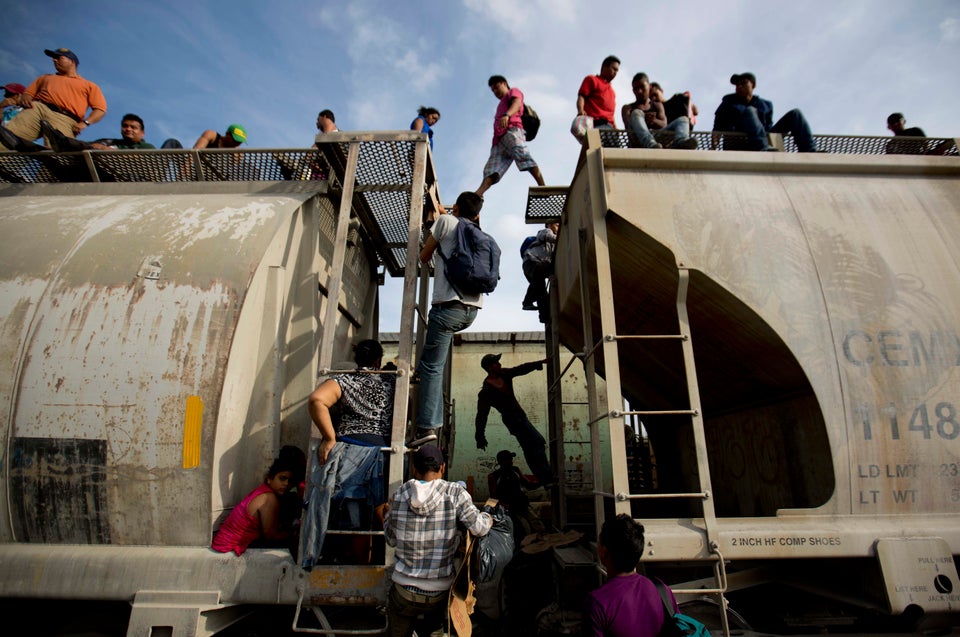TUCSON, Ariz. ― One morning last October, Irlando sat hunched over a table in the back of a federal courthouse, looking to a court-appointed lawyer for help. Border Patrol agents had found him the day before, wandering through the desert 150 miles away outside Lukeville, Arizona, and he still hadn’t showered. His hands were black with grime and he smelled of dried sweat after spending almost a week trekking in the hot sun.
Irlando had worked as a commercial truck driver in a town north of Guatemala City and fled his homeland after a local gang started extorting his company. First, they killed drivers when the company didn’t pay up. Then gang members killed his boss, and Irlando decided he had to escape.
A friend suggested he try to make it through Mexico and into the United States, where he could earn enough money to help support his wife and four children he was leaving behind. His youngest daughter was just two months old. When Border Patrol picked him up crossing into Arizona, he’d been thankful just to have a sip of water. But now the reality was sinking in: He was going to be deported back to Guatemala.
Irlando’s lawyer, Eréndira Castillo, said she was sorry, but none of his backstory would matter to the judge. He wasn’t in immigration court. He was facing a criminal prosecution for crossing the border illegally, and this judge had no authority to decide whether he should stay in the country. All the judge would see is that he was arrested while trying to jump the border and that he had a prior conviction for attempting to do the same thing in Texas in 2013.
(Castillo talked to Irlando privately about his right to confidentiality and he decided to waive that right so his story could be told, on the condition that only his first name be used.)
Irlando could accept the plea agreement in front of him, which came with a 75-day jail sentence, or he could take his case to trial, where virtually all defendants lose, and then face two years in prison. Either way, he’d almost certainly be deported after his release.
It was about 9:30 a.m., and Irlando needed to make up his mind before the proceedings started that afternoon. After a few minutes of discussion, he took the plea deal, which was typed in English. Castillo verbally translated the document for him before he signed it.
“There’s no one to tell that I’m here trying to save my life?” Irlando asked his lawyer. “My baby girl needs three bottles of milk every week. Who’s going to give them to her?”
“It’s very sad, but that’s the way it is,” Castillo replied, patting him on the knee. “The law doesn’t have a heart.”
Improvising An Immigrant-Prosecuting Machine
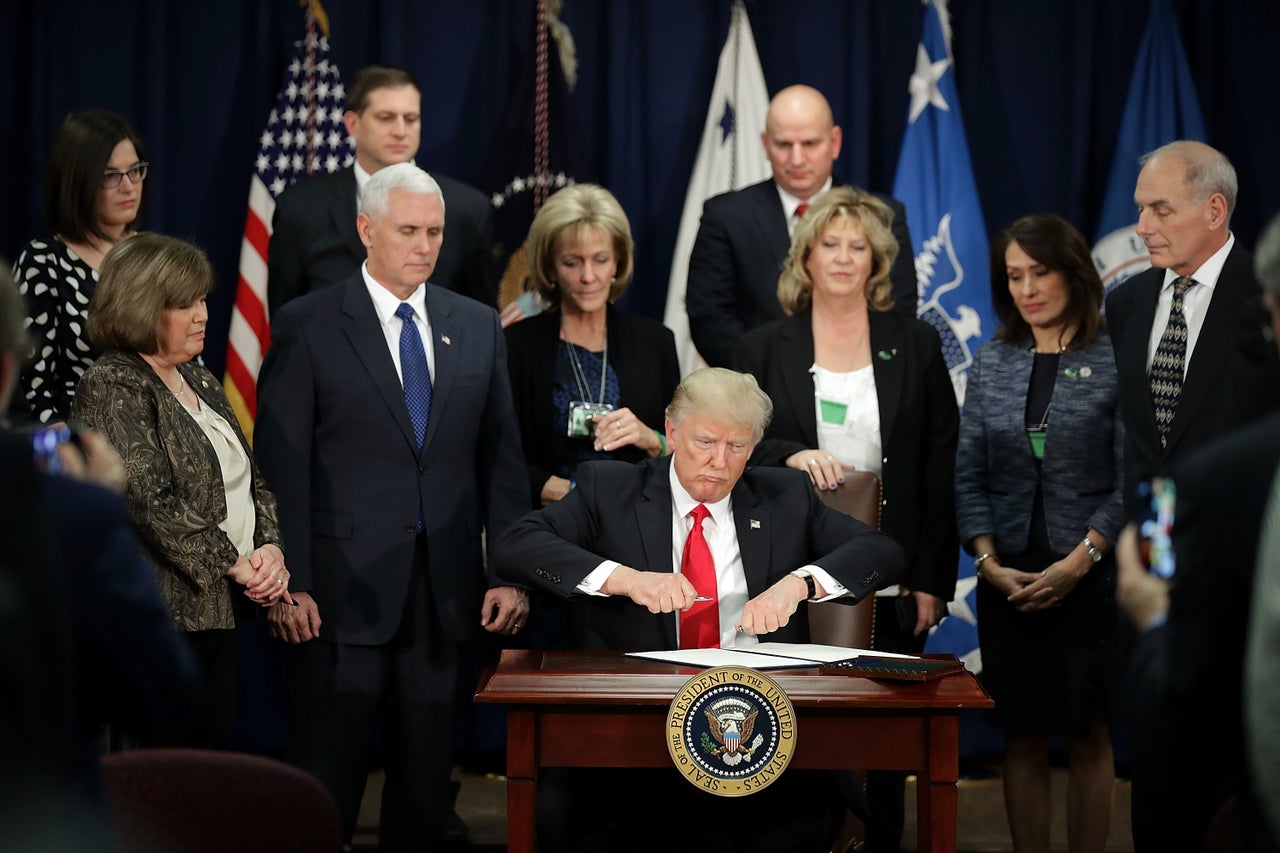
When President Donald Trump took control of the immigration enforcement system, he inherited a well-oiled machine for prosecuting immigration violations that has continued to grow even as illegal border crossings decline. When Trump talks about imposing a “deportation force,” most observers interpret that as a reference to Immigration and Customs Enforcement or Border Patrol. But the most powerful tool he wields against unauthorized immigrants may well be the criminal courts.
While residing in the U.S. without authorization is a civil offense, the act of crossing the border illegally is a misdemeanor, punishable by up to six months in jail. Those who get caught again face the felony charge of “illegal re-entry,” with a prison sentence of up to two years that can expand to two decades if the offender has a criminal record.
Today, roughly one-quarter of immigrants expelled from the U.S. face criminal prosecution for crossing the border illegally and serve jail time before they are deported. Immigration prosecutions topped 91,000 in 2013 ― 28 times the number of prosecutions in 1993.
This marks a fundamental transformation of both deportation policy and the federal courts. While less than 5 percent of federal prosecutions involved immigration in 1993, the first year of Bill Clinton’s presidency, illegal entry and re-entry prosecutions now account for roughly half the federal criminal docket, sapping limited resources to prosecute violent or white-collar crimes.
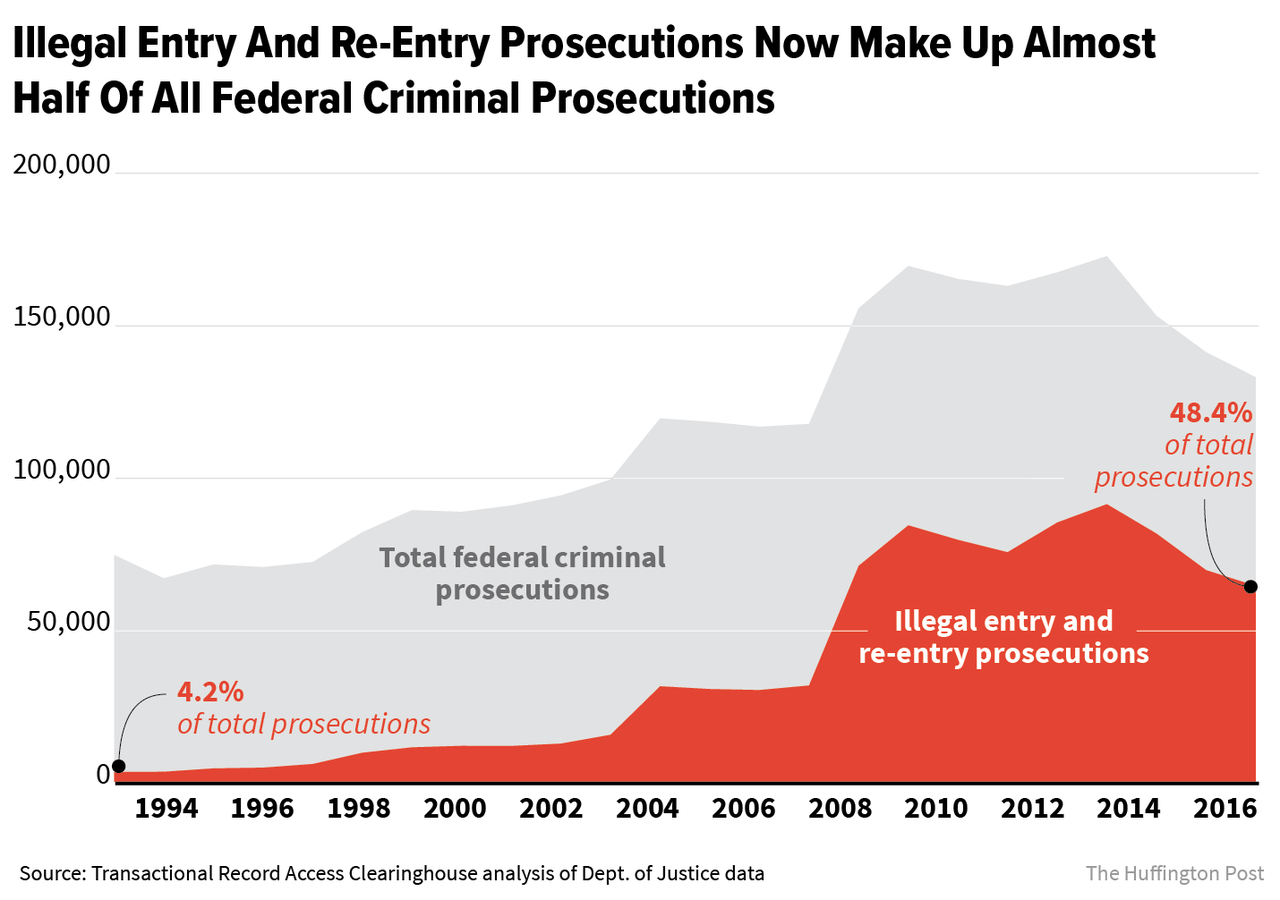
Immigration authorities have had the power to refer migrants caught making illegal crossings to the criminal courts since the passage of the Immigration and Nationality Act in 1952. But the Justice Department’s priorities didn’t begin their steady shift until the Clinton era.
Entering office during one of the largest mass migrations from Mexico in U.S. history and nearly a decade after President Ronald Reagan extended a pathway to U.S. citizenship for some 3 million people, Clinton faced major public backlash against illegal immigration and bipartisan hostility toward incoming migrants. Prior benevolence, Democrats and Republicans largely agreed, had only encouraged more illegal crossings.
Clinton signed immigration reform laws that fast-tracked deportations and helped lay the foundation for the sprawling immigrant detention system that now reserves space to lock up 34,000 immigrants at a time. In a less-publicized development of his presidency, the number of immigration prosecutions ― particularly felony cases ― also steadily crept up, although the process was haphazard and no formal policies governed whether the migrants arrested should face criminal or civil penalties.
That changed dramatically during George W. Bush’s presidency. Seeking a way to deter unauthorized immigrants more effectively, Customs and Border Protection began formalizing a whole host of previously informal policies.
In one of the most sweeping changes, CBP teamed up with the Justice Department to funnel more people who jump the border into criminal court. The model program, called Operation Streamline, was implemented in southern Texas in 2005, when a sudden influx of Central American migrants left immigration authorities with a shortage of bed space in immigrant detention facilities.
“We were taking a look at what consequences were available to us within existing law,” David Aguilar, a top Border Patrol official in the 1990s and CBP commissioner from 2011 to 2013, told HuffPost. “Prosecution was in fact one of those consequences.”
Because the laws were already on the books, neither CBP nor the Justice Department needed to ask Congress for approval. The new system spread over the next decade, immigration violations swallowed up an ever-larger chunk of the federal criminal docket. The number of criminal immigration prosecutions doubled over Barack Obama’s two terms in office, despite the fact that illegal crossings plummeted by roughly half between 2009 and 2016.
The continued criminal prosecution of illegal border crossings meant America’s first black president jailed more people of color on federal charges than any president in modern U.S. history. But because the Justice Department classifies almost all Hispanics as “white” in official statistics, that fact has largely been obscured.
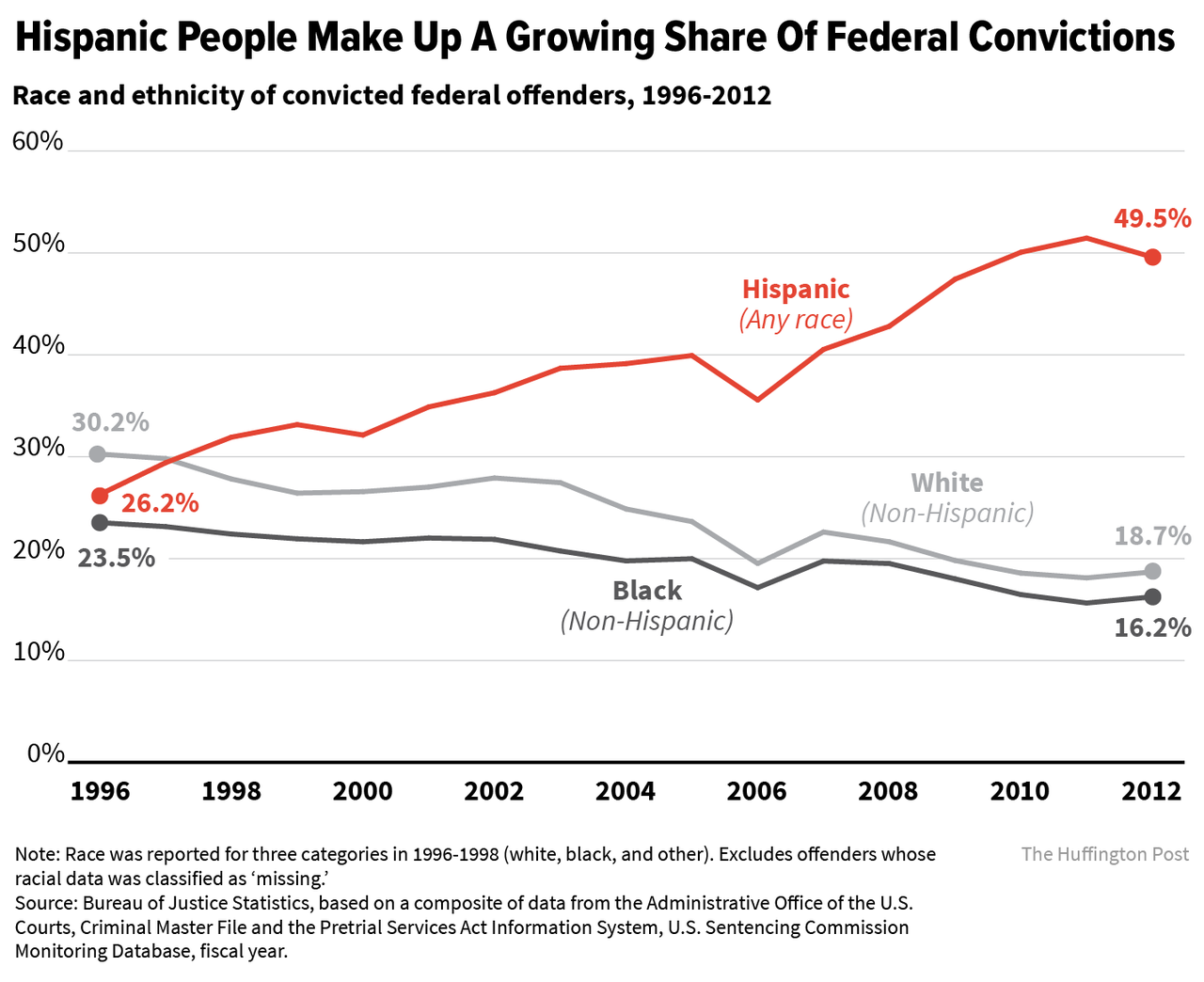
The immigrant-prosecuting machine improvised under Clinton, formalized under Bush and institutionalized by Obama barely merited a mention during last year’s immigration-obsessed presidential election. But Trump noticed.
On the campaign trail, he pledged to raise the mandatory minimum sentence for illegal re-entry to five years. Within a week of taking office, he issued an executive order cracking down on sanctuary cities that contained a provision calling for more immigration prosecutions.
On April 11, Attorney General Jeff Sessions announced plans to consider criminal charges for any person caught in the U.S. who has been deported before, regardless of where they’re arrested ― a massive expansion of a constitutionally questionable process that routinely sucks in asylum-seekers and people with long histories in the United States.
“It’s going to break the bank in terms of paying for the jail and prison beds that these people are going to occupy if they are prosecuted,” said Judy Greene, the author of the book Indefensible: A Decade of Mass Incarceration of Migrants Prosecuted for Crossing the Border.
“But that’s only one way to look at the cost,” she added. “The other way to look at it is to realize there is a huge cost in human misery for the people who are prosecuted ― their families, their neighbors ― if this happens the way Trump and Sessions have envisioned.”
Two Decades Defending Immigrants
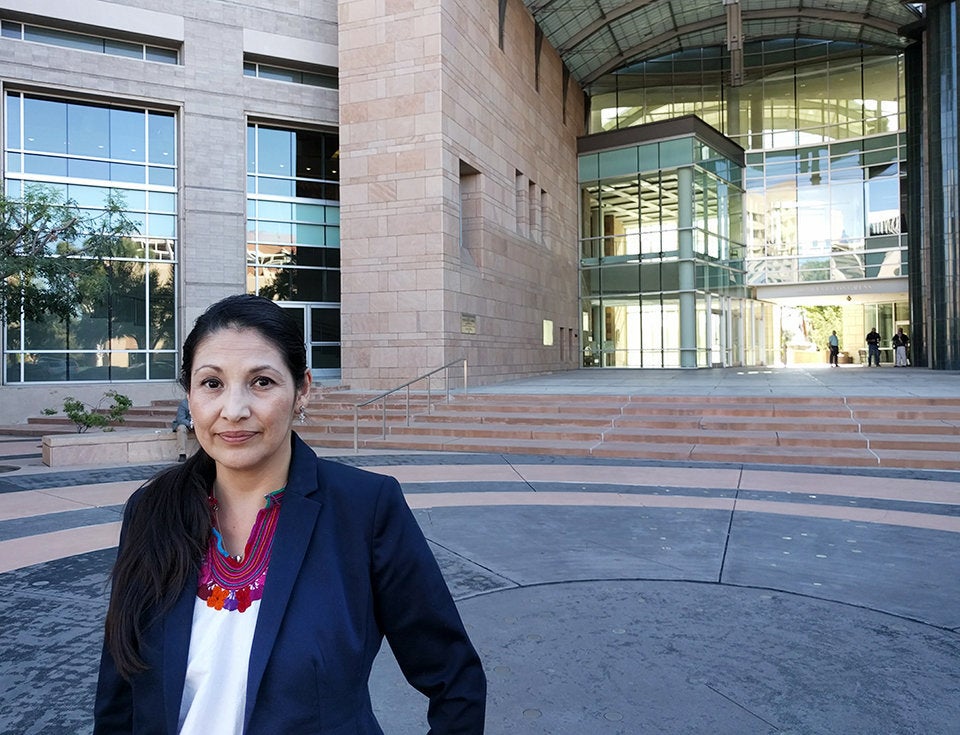
After meeting with Irlando that morning last fall, his lawyer, Castillo, walked to a nearby restaurant where she half-heartedly picked at a pair of tacos. A first-generation Mexican immigrant who speaks Spanish with native fluency, Castillo wears her black hair in a ponytail and an indigenous embroidered shirt called a huipil beneath her dark blue blazer. She loves practicing law, but hates cases like Irlando’s.
“It’s so upsetting, because I feel complicit,” she told HuffPost.
Castillo has worked these cases since 1998, when she joined the Federal Public Defender’s Office in Tucson to help expand its immigration unit. The job initially excited her: She’d already begun to specialize in immigration before going to law school, processing legalization applications for undocumented immigrants who became eligible to apply for U.S. citizenship under Reagan’s 1986 reform law.
But Castillo’s enthusiasm faded as she faced uncomfortable situations that seemed to flout basic protections for criminal defendants, like the right to due process or the right to keep communications with your attorney confidential. The process from initial hearing to conviction and sentencing ― which routinely takes months, even years, in felony criminal cases ― was collapsed into a few hours for dozens of people at a time. She only got a few minutes to speak with each client, and they spoke in an open room where others could hear their conversations.
“I was a brand-new lawyer,” Castillo said. “[Our bosses] never said, ‘This is the right way, this is the wrong way, this is what we expect from you.’ We just did what they said. I think, in retrospect, I would say, ‘No, the federal public defenders office shouldn’t be doing it this way. This is unconstitutional.’”
Many legal experts agree. But their objections haven’t kept the system from growing. Within five years of joining the public defender’s office, the immigration unit Castillo helped pioneer had grown larger than the office’s entire criminal defense unit ― a reflection of the Justice Department’s shifting priorities.
Castillo left the public defender’s office for private practice three years ago, but still defends immigrants accused of illegal crossings once a week. She takes pride in making small gestures to make the process less painful: offering her clients a glass of water, or calling their family members so she can tell them what’s happening. (The clients aren’t allowed to use the phone in court, so she calls on speakerphone while they listen in silence.)
“I have to explain it’s not my fault,” Castillo said. “I’m a lawyer, I was appointed by the court.”
‘This Process Does Get Somewhat Repetitive’
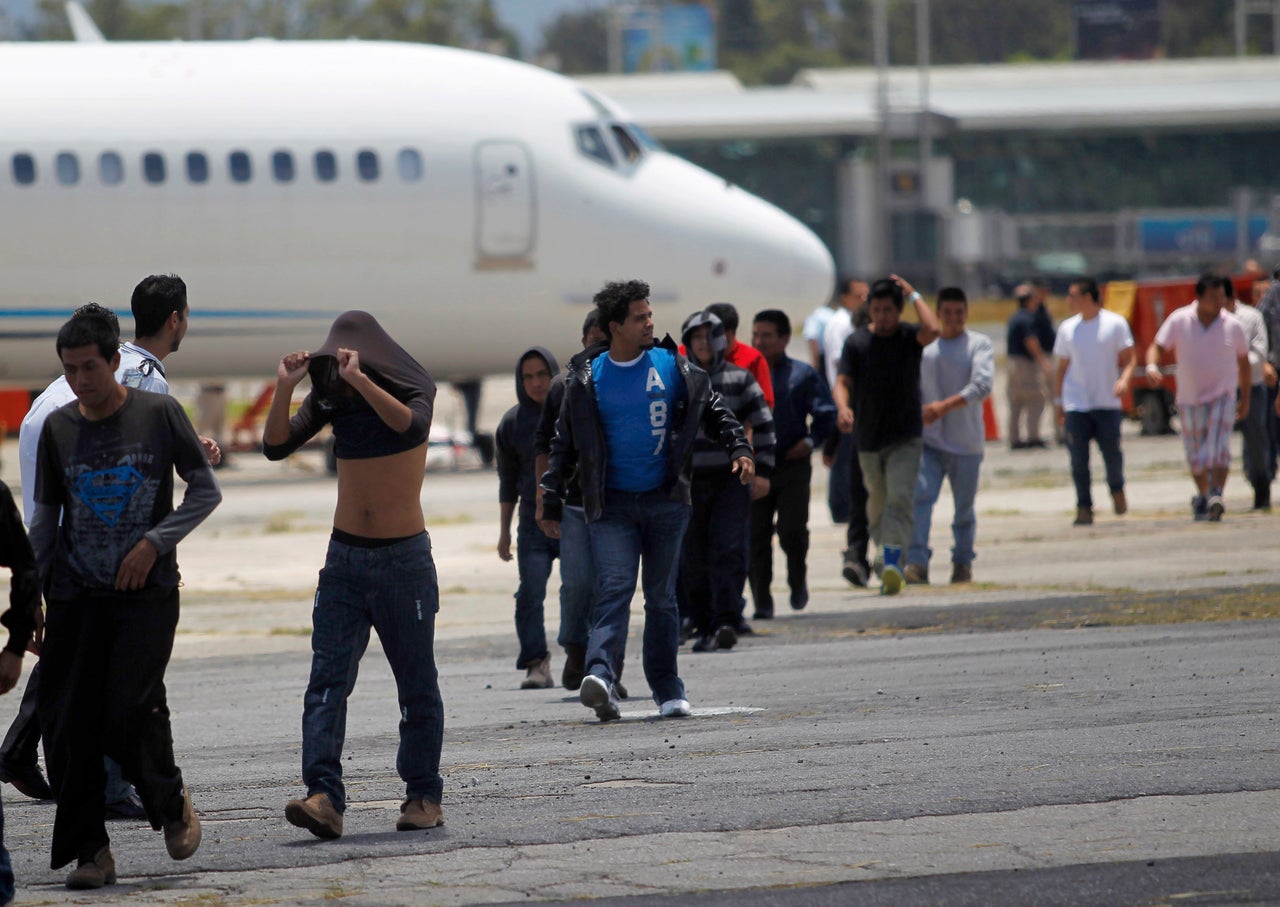
Irlando’s hearing started at 1:30 p.m. A row of five microphones stood in front of Judge Bruce Macdonald. Each of the 41 defendants, lined up on benches before the judge, was a brown-skinned national of Mexico or Central America. They’d already signed plea agreements like Irlando’s, differing only in the length of their sentences.
Macdonald took the bench and explained the process. Everyone would acknowledge their guilt in groups of five. He asked the 14 defense attorneys if their clients were competent to go forward with their hearings. They affirmed in unison. “You’ll quickly notice that I’m asking the same series of questions,” Macdonald told the defendants. “This process does get somewhat repetitive.”
When Irlando’s turn came to plead guilty, Castillo mentioned his fear of returning to Guatemala. The judge said Irlando would be able to raise the issue once he was transferred to immigration court for deportation proceedings after his jail sentence.
At least three other defendants said they feared for their safety if deported. Border Patrol policy dictates that they should have been channeled to an asylum officer or a civil immigration court to hear those claims, but the judge gave them the same reply he gave Irlando.
Several people seemed only hazily aware they faced criminal prosecution at all. One woman, asked how she pleaded, said “yes.”
Three defendants, all of them Guatemalan and all represented by the same attorney, said they didn’t speak Spanish as a first language. (A foreign government official, who declined to be identified because he was not authorized to speak with the media, later told HuffPost there were seven indigenous defendants that day who didn’t speak fluent Spanish.) Macdonald quickly moved on after the lawyer insisted the indigenous language speakers understood the agreement.
The lawyer representing the three indigenous Guatemalans declined to comment about their cases, but acknowledged he wasn’t well qualified to handle their claims. “I don’t really know about immigration,” he said. “I usually call up a friend if there’s an asylum issue to get advice.”
The Consequence Delivery System
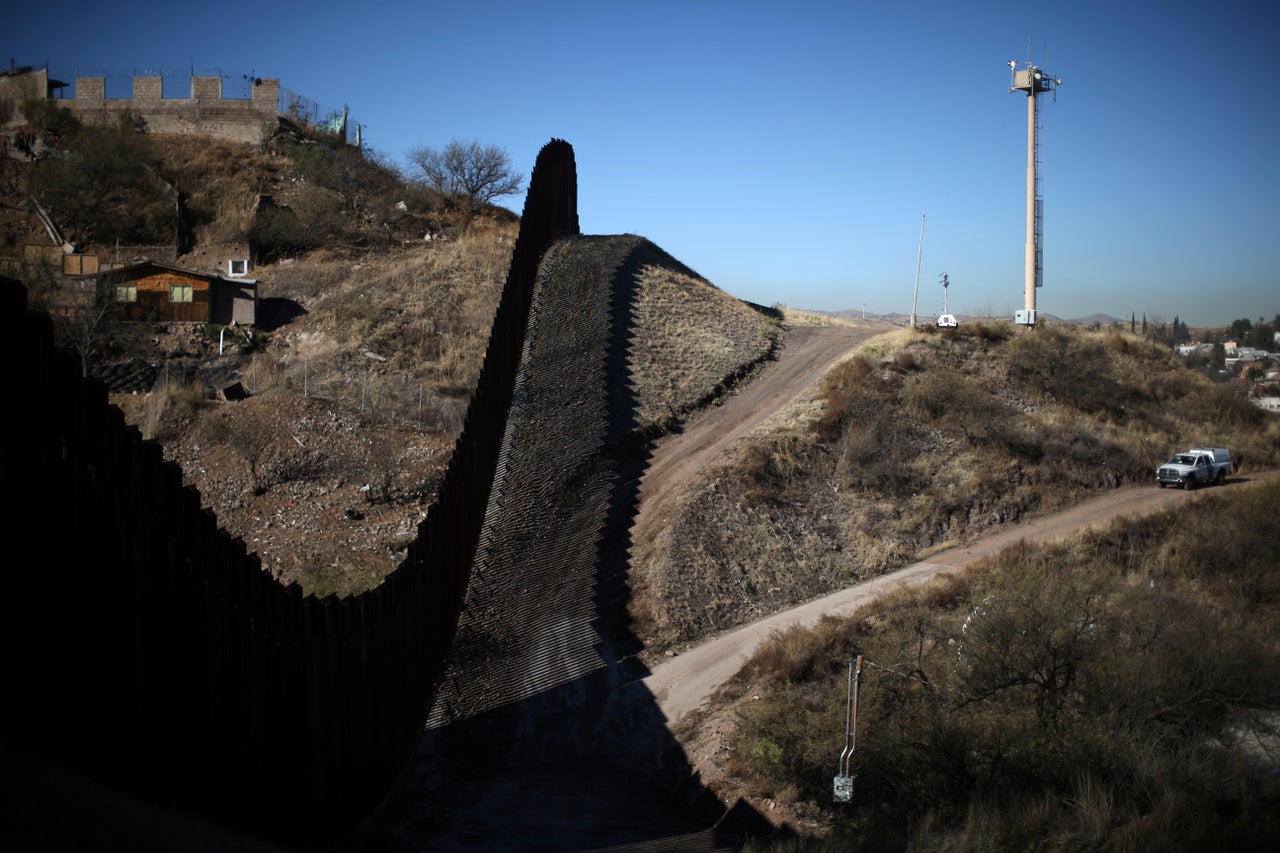
About the same time Castillo first went to work defending immigrants facing prosecution in Tucson, John Lawson arrived in the Arizona town of Douglas as a newly minted Border Patrol agent. The town is roughly 260 miles east of where Irlando was picked up crossing.
In 1997, Lawson found only about 100 yards of fencing separating the United States from Mexico. That was a year authorities caught 1.4 million people crossing the border illegally ― almost four times the rate of apprehension in 2016. At that time, Border Patrol had half as many agents trying to stop those migrants, and the barrier between the U.S. and Mexico in that area was an opaque wall, so agents couldn’t see people throwing rocks and or lobbing cinder blocks at passing patrol cars.
“It was kind of Wild West out here,” Lawson said as he led a tour of the border at Nogales in October. “It was insanity, everyone trying to catch who they could.”
In the 1990s, Border Patrol agents usually escorted people they apprehended back to the other side ― a procedure known as “voluntary return.” Unlike a formal deportation, a voluntary return has no legal consequences and returnees can apply for a U.S. immigration visa a minute after returning to Mexico. It wasn’t uncommon for Lawson to catch the same person crossing illegally three times in a single day.
Border Patrol agents struggled to deter people from simply crossing again. Mexico was limping through an economic crisis in the mid-1990s, just as the country’s 1970s baby boom generation reached working age. The 1994 North American Free Trade Agreement made matters worse, compelling some 2 million Mexicans to flee the country’s farms when they couldn’t compete with subsidized agricultural imports from the United States. Foreign-owned assembly plants sprouted in border towns to take advantage of the cheap labor and lower import taxes NAFTA offered, which pulled out-of-work Mexicans to cities within walking distance of the United States like magnets.
Border Patrol couldn’t control the underlying reasons for the immigration explosion, so the agency worked to make deterrents more effective. Rather than returning the migrants they arrested to the same cities where they crossed, agents might bus them hours away, making the crossing more expensive and breaking the link between migrants and their smugglers. Instead of voluntary removals, Border Patrol increasingly sent unauthorized immigrants to get fingerprinted and face formal deportation proceedings.
“Now everyone gets an alien registration number,” Lawson said. “That’s as permanent as it gets. It stays with you for the rest of your life.”
By the mid-2000s, CBP had institutionalized these policies into a list of penalties the agency calls the “consequence delivery system.” The harshest of those consequences is criminal prosecution.
Lawson is proud of CBP’s work. The sporadic links of opaque fencing have stretched into hundreds of miles of steel beams, which are reinforced with cameras and underground sensors. People scale the barrier so often that the rust has scraped off some of the beams, but Lawson is confident that agents catch most of the people who make it over.
When they do, the migrants’ fingerprints tell them everything they need to know. If a person has tried to cross illegally within the last two decades, a record of the deportation appears. If he or she has ever committed a crime in the United States, that’s there too. Though there are some exceptions ― children, asylum-seekers or people who appear sick ― agents are supposed to deal out a consequence to every unauthorized migrant they apprehend.
There’s only enough slots at the federal courthouse in Tucson to prosecute 70 border-crossers per day. If agents find more unauthorized migrants near that jurisdiction, they’ll face deportation instead. But these days, there are far fewer illegal crossings, so the courthouse rarely fills to capacity for its daily three hours of illegal entry and re-entry cases.
“There’s a bunch of reasons why that could be happening,” Lawson said. “But we’re fairly certain that a lot of it has to do with these consequences.”
Prosecuted Far From The Border
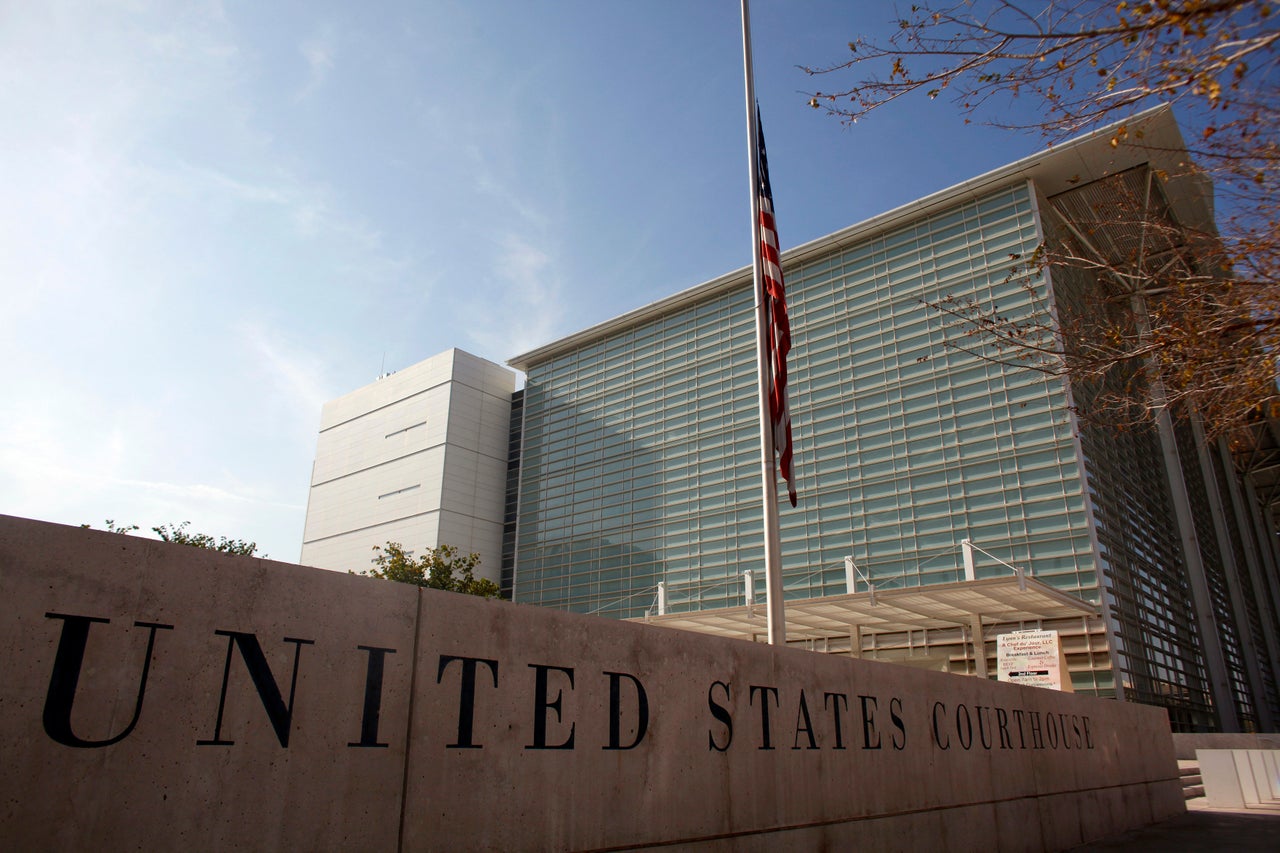
These prosecutions aren’t just happening to migrants picked up along the border. Felony illegal re-entry charges were filed in all but four of the 94 U.S. district courts last year.
Around the time Irlando was convicted, a gray-haired woman stood before a judge in a federal courtroom in Phoenix in a red jumpsuit, shackled at the wrists and ankles. Two of her daughters, both born in the United States, watched from the benches.
The woman, whom HuffPost is not identifying because her family fears she’ll be deported, was born in the Mexican state of Michoacán but came to the U.S. when she was 9 years old. In 2003, she spent two months in jail for heroin possession and distribution charges, and was then deported. She returned illegally soon after, as unauthorized immigrants with U.S.-born children often do.
She found work cleaning houses and avoided trouble with the law, but ICE arrested her last year. Her daughters are unsure why their mother was targeted, but suspect someone may have reported her.
Given her 13-year-old drug charges, the woman had little choice but to take a plea agreement. To secure a conviction, the only evidence prosecutors needed was a prior order of deportation. Each conviction on a person’s record can enhance their jail sentence. She faced the possibility of 10 years in prison, but was released on time served ― seven months ― in February after taking the deal.
“It’s very sad, but that’s the way it is. The law doesn’t have a heart.”
- Attorney Eréndira Castillo
It’s unclear whether she was deported. The woman’s attorney, Kaitlin Verdura, declined to discuss the specifics of her client’s case, but said her situation is not uncommon. “There are people in the United States that have been here for a very long time, who have assimilated into the country, and get prosecuted for the crime of illegal re-entry,” she said.
When Sessions announced on April 11 the Justice Department’s plans to consider prosecution for anyone who enters the country illegally, he likely wasn’t directing his attention at border-crossers like Irlando. People like the woman in Phoenix will probably bear the brunt of the Trump administration’s changes. The Justice Department did not reply to HuffPost’s request for comment.
It’s unclear how many of the 11 million undocumented immigrants who live in the United States have deportations on their records. But the number is likely high, given Border Patrol’s efforts to make sure most people the agency apprehends pass through formal deportation proceedings.
Since prosecutors can easily secure convictions for illegal re-entry, Sessions’ order could fundamentally transform the federal justice system in a way CBP never imagined when it recommended systematically hauling border-crossers into criminal court with Operation Streamline in 2005. People nowhere near the border who would’ve previously been deported could further swell the court system and federal prisons.
‘Legalized Racism’

Castillo sees the direction the Justice Department is moving under Trump and it unsettles her. Even after two decades of serving agreements to people pleading guilty of immigration violations, she rarely thinks of her clients as criminals. She sees parents trying to return to their children, jobless people looking for work, and people like Irlando who are scared for their lives.
She’s fought losing battles to convince judges that the weight of the law falls too heavily on her clients. She’s represented people who grew up in Phoenix and wound up with criminal records at a time when former Maricopa County Sheriff Joe Arpaio famously targeted Hispanics for traffic stops to identify undocumented immigrants.
A federal court ruled in 2013 that those tactics amounted to racial profiling and ordered him to stop. But some of the people who got profiled and wound up with convictions and deportations showed up later in federal court for illegal re-entry charges. They face enhanced penalties that can boost their sentences up to 20 years.
“It’s legalized racism,” Castillo said. “That’s the whole problem with the criminal justice system ― we’re not allowed to talk about racism as a factor of a person’s story. But their criminal records are overrepresented ... I’ve brought this up in court and the judges just sort of look at me with this blank stare.”
Like most of Castillo’s clients with immigration convictions, Irlando served his 75 days in the custody of the U.S. Marshals Service, then faced a swift deportation back to Guatemala. Despite Judge Macdonald’s assurances, the immigration court never heard his appeals about how he feared for his safety back home. “They didn’t listen to anything I had to say,” Irlando said on a phone call from Guatemala last month.
Unable to return to his old job, he now works planting corn. He said he feels safe for the moment, but is unsure about his future in Guatemala. “Who knows,” he said. “I might try to cross again.”

